
Number 300 is a "Pershing" engine, built by Baldwin Locomotive Works in 1917 for the United States Army
to use in Europe during WWI. Only two Pershing engines survive. Instead of being shipped to Europe
this one was assigned to Camp Polk Army Base in Leesville, Louisiana. After that, it had a long career
of hauling lumber for private railroads in Louisiana and East Texas. Engine number 300 weighs
83 tons and it can produce a tractive effort of 35,610 pounds.
BritishV8 2012: Visit to the Texas State Railway Maintenance Facility
as published in BritishV8 Magazine, Volume XX Issue 1, July 2012
by Curtis Jacobson, with technical notes by Larry Shimp
Rusk to Palestine or Bust
One highlight of our 2012 BritishV8 meet was a guided tour of the Texas State Railway's maintenance
facility at 2503 West 6th Street in Rusk, Texas. The railway operates both steam and early
diesel-electric powered locomotives between depots at Palestine and Rusk. The twenty-five mile
route is a popular excursion for tourists. The railroad also offers educational programs and an
evening dinner train. Its facilities have been used for many historical reenactments and for movies.
Frankly, I arrived rather late due to a poorly scheduled fuel stop. I'm sure I missed many fascinating
parts of the tour, but I did get enough to inspire further research on my own time. I'll include some
of what I learned here.
Back in the golden age of steam locomotion, public and private railroads criss-crossed the North
American landscape, providing every sort of service imaginable. Somehow though, the private
railroads that might have served the quiet East Texas town of Rusk decided to bypass it instead.
This problem was greatly compounded in 1881, when a large new state prison opened in Rusk. So
many prisoners to put to work! The prison warden thought the East Texas hills might be a splendid
place for iron mines, and that the prison might profitably operate a smelter to produce pig iron
billets. This would only make sense if the prison were connected to the nation's rail network.
The warden committed to laying a spur line. Ultimately, that modest spur line evolved into
the grandly named Texas State Railway.
Prison inmates performed all the timber cutting, grading, bridge building, and track laying to
create the spur line. Prison work groups were also provided to the adjacent Kansas & Gulf Shortline
Railroad Company to upgrade and extend their facilities. Side spurs were built left and right to support
the prison's growing industry. For example, lumber camps were established to supply fuel for the iron
smelter. However, it wasn't until the 1890s that the prison railroad really took off. Under a new state
governor named Jim Hogg, who just happened to be from Rusk, the prison was authorized to extend the
railbed westward to connect with the International & Great Northern railroad at Palestine.
Railroad building is slow work at the best of times. Railroad construction to Palestine stopped and
started repeatedly as occupants changed at the Governor's Mansion in Austin. In January 1907
Thomas Campbell, who just happened to be from Rusk, was sworn in as Governor and in April 1907 he
pushed through and signed The Texas State Railway Bill. Under Campbell's authority, the railway
between Rusk and Palestine was finally completed in July 1909. At that time, the total length of
railbed including spurs totaled 32.5 miles.
Although the original rationale for the railway was shipment of iron, iron production never really
amounted to much in East Texas. The first back-up plan was lumber production, but in September 1909
the huge state-owned sawmill at nearby Mewshaw (also operated by prisoners) burned to the ground.
The Texas State Railway primarily served local passenger traffic and mixed freight. It was never
profitable, but it managed to survive through the 1960s. From 1970 on, the railway has operated as
a tourist attraction. From 1972 through 2006 the railway was operated by the Texas State Parks &
Wildlife authority. In 2007 it as sold to a private company. As of this writing, it is currently
"For Sale" again.
Photos From Our Visit!
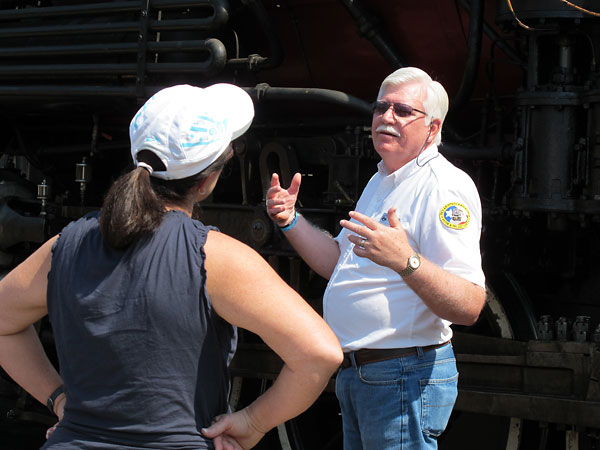
Jean Ingram tells Driver Eight to take a break: "Take a break, Driver Eight."

Actually, the nice man was telling Jean Ingram the etymology of the expression: "the real McCoy".
Elijah J. McCoy (1844-1929) was an African-American inventor who was awarded 57 U.S. patents.
McCoy achieved fame through his superior quality automatic oiler mechanisms, which dramatically
reduced maintenance problems for the railroad and shipping industries. Although many, many
competitive and copy-cat oilers were available, railroad engineers insisted on the real McCoy.
|
Technical Notes:
Note the vertical lever with the curved slot. It provides variable valve timing and lift. (Obviously this mechanism predates the computer controlled variable valve control mechanisms on modern cars, by about a hundred years!) The lever oscillates from a rod connected to a crank on the middle drive wheel. A second rod runs from the slot to the valve which is located in the housing above the drive cylinder. In this photo, the valve rod is in the middle position which means it doesn't move when the slotted lever oscillates. In this position, the engine will not move even if the throttle is opened. When the valve rod is at the bottom of the slot, the locomotive moves forward and the valve moves for its full stroke in the forward direction of movement. When the valve rod is at the top of the slotted lever, the locomotive runs in reverse, and the valve moves for its full reverse stroke. In other words, it is 180 degrees out of phase from the forward running position. But what about in-between positions? As the valve rod is moved closer to the center of the slot, the valve stroke decreases making the valve close earlier. This is vital to locomotive efficiency. Upon starting, maximum torque is needed, so the full steam pressure is allowed into the cylinder for a major part of the piston stroke. As speed increases, greater efficiency is obtained by allowing steam into the cylinder for only a small part of the piston stroke, so that the steam can expand. This is known as reducing the "cut off". The goal is to have as low an exhaust pressure as possible; letting steam out of the cylinder at high pressure means that much of the energy in the steam is wasted. Also, as with a gasoline engine, losses in manifolds and valves reduce efficiency and power. So, to get the maximum efficiency by having the highest starting pressure in the cylinder and the maximum expansion, it is good practice to run a steam locomotive with as wide open a throttle as possible, and to control speed with the cut off. |
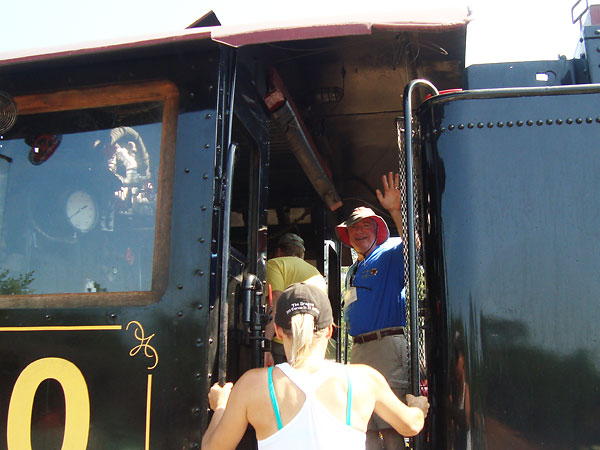
That's our friend Scott Costanzo in the "Thomas the Tank Engine" T-shirt.
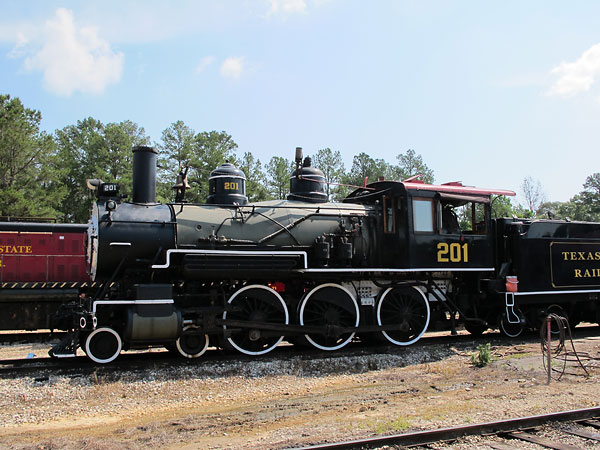
Engine number 201 is the oldest operable engine in the collection. Built in 1901 by the A.L. Cooke
Locomotive Works for the Texas & Pacific Railway, for freight service. In 1951 an anonymous donor
purchased the engine and donated it to the city of Abilene to honor their seventy-fifth anniversary.
It was displayed in Oscar Rose Park until 1974, when donated to the newly formed Texas State
Railroad. Engine 201 weighs 79 tons and can produce a tractive effort of 28,000 pounds.
|
Technical Notes - Continued:
Even as steam enters one end of a locomotive's cylinder, it's being pushed out the other end. Valve timing is always set so that the exhaust closes just before the end of the exhaust stroke, which means that the piston is compressing steam at the end of its stroke. This cushions the heavy piston and helps start it on its reverse movement, thereby reducing strain on the connecting rod bearings. But a problem is that if too much water condenses in the cylinder it will be trapped and (usually) result in a broken cylinder head. Such conditions occur, for example, as steam is admitted to the cylinders of a locomotive after coasting down a hill for a time with no steam to the cylinders. It can also be a problem on starting from rest, but the more likely result then is hydraulic lock and not broken parts since little inertia is built up yet. For this reason, pressure relief valves were built into some steam locomotives, and all steam locomotives have engineer-controlled cylinder drain valves to let out condensed water. When these are open, great clouds of steam escape from the bottom ends of the cylinders. Starting in the early 1900s locomotives were often equipped with devices something like intercoolers. Actually, they didn't cool the steam - they "superheated" it. Still, the principle is that the steam went through a device that changed the gas temperature before reaching the cylinders. Superheaters are a series of U-shaped tubes that fit in the lower boiler flues where they are exposed directly to the heat of the fire. This typically raises the steam temperature to between 500 and 700 degrees (without changing the pressure, which is set by the boiler). Superheated steam will eliminate any tendency for the steam to condense to water in the cylinders while running under average conditions. Ordinary saturated steam suffers from slight condensation, and even small amounts of condensation significantly lower the cylinder pressure and therefore reduce efficiency. Most readers are probably familiar with automotive turbochargers, which mechanically boost the pressure of induction airflow. Similarly, practically all steam locomotives utilize a form of exhaust induced combustion airflow! Locomotive boilers are very compact for the amount of steam they have to produce, so natural airflow cannot begin to supply enough combustion air. The tried and true solution is to have exhaust steam flow through an open venturi arrangement between the end of the exhaust pipe and the smokestack. This exhaust flow creates a strong vacuum in the smokebox that pulls air through the firebox. Like a turbo charger, this arrangement pulls more air under heavy loads when it is needed most. When the locomotive is stopped, the engineer opens a valve that supplies a small steam jet which keeps air flowing. Note that when the fire is first lighted in a cold boiler, pressure build-up is slow until there is enough steam pressure to power the steam jet. |
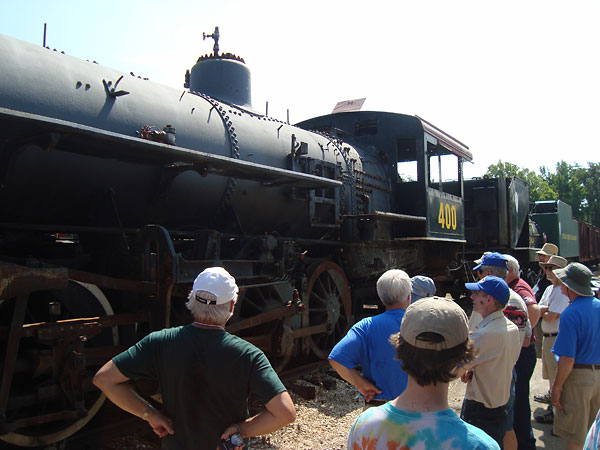
Engine number 400 was built by the Baldwin Locomotive Works in 1917 for the Tremont & Gulf Railway,
of Louisiana who operated it until 1954. It was sold to the Magma Copper Mine in Arizona. During its
years at the mine, it was used in the movie How the West Was Won (1962). The mine replaced its
steam engines with diesel in the late sixties, so it was available for the Texas State Railroad to
purchase. Engine 400 weighs 87 tons and can produce a tractive effort of 37,400 pounds.
|
Technical Notes - Continued:
A big firebox is the key to more locomotive power. Just as with a car, the more fuel that the engine uses, the more power that can be generated. Locomotive 300 (above) is similar to locomotive 400 (shown here) except that locomotive 300 has its firebox over the rear drive wheels while locomotive 400 has its much larger firebox behind the drive wheels. Both locomotives have similar starting tractive forces, meaning both can get similar sized trains rolling. Tractive force is a function of number of driving wheels, diameter of driving wheels, weight on the driving wheels, cylinder diameter, and boiler pressure - all of which are similar for the two locomotives. However, locomotive 300 can only pull a heavy train at a low speed because the fire cannot produce steam at a high rate, while locomotive 400 will pull the same train at a significantly higher steady speed before steam production runs out. |
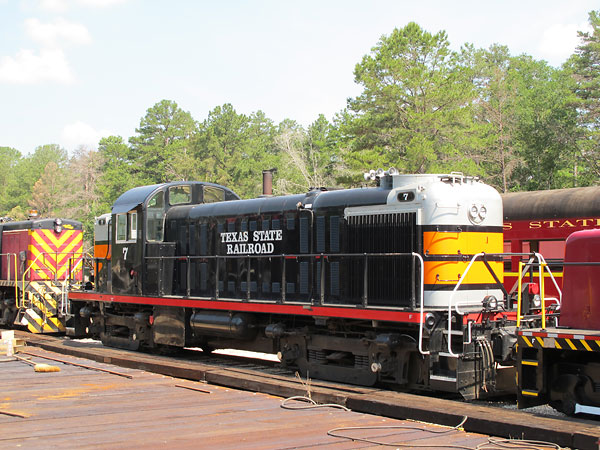
Engine number 7 is the second oldest diesel in the collection. Built in 1947 by the American Locomotive
Company (ALCO) at Schenectady, New York for Alcoa, it served the aluminum manufacturing plant at Point
Comfort, Texas. This engine represents the first wave of diesel engines that started replacing steam
engines immediately after WWII. Engine 7 weighs 120 tons and is rated 1500 horsepower.
|
Technical Notes - Continued:
In the 1930s, the major steam locomotive companies: Baldwin (with Westinghouse electrical equipment), Lima, and American Locomotive Company (with General Electric as a partner) were experimenting with diesels. At the same time, General Motors was also building diesel locomotives as a new business venture (Electro Motive Division or EMD). During WWII the government ordered the steam locomotive companies to concentrate on steam locomotives but let GM develop diesels. At the end of the war, GM and the locomotive manufacturers were joined by Fairbanks Morse who began building diesel locomotives using the highly successful diesel generator sets they developed for submarines. (The Germans also used submarine technology on their railroads in the form of electric commuter cars powered by submarine battery packs.) But GM was already working on its second generation while the others were on their first generation. The technical lead GM had built up could not be overcome and all the other manufacturers eventually stopped making locomotives. However, General Electric dissolved its partnership with ALCO and continued on its own. GE is now the dominant locomotive builder in the US. Westinghouse went into the nuclear power plant business and for a while Baldwin built reactor pressure vessels using its expertise in metal fabrication. |
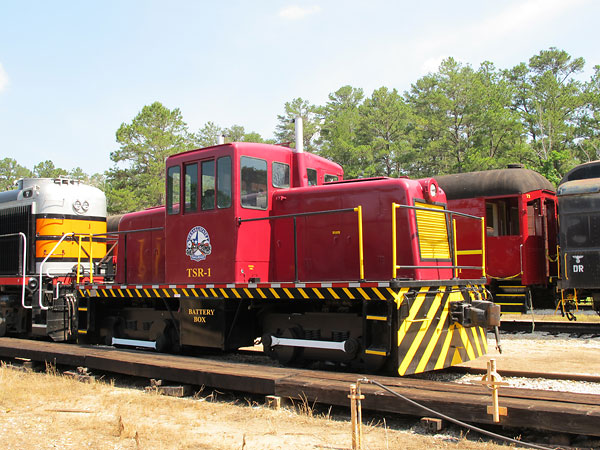
Engine number 1 is a General Electric "45 tonner" diesel switcher. This one was built in 1947. Its dual
150hp Cummins six-cylinder engines spin two separate generators, which in turn power dual traction
motors - one at each end. These little mules can push around up to twenty loaded freight cars.
However, because of their low gearing they typically can't travel faster than 20mph.
|
Enjoying this article? Our magazine is funded through the generous support of readers like you! To contribute to our operating budget, please click here and follow the instructions. (Suggested contribution is twenty bucks per year. Feel free to give more!) |
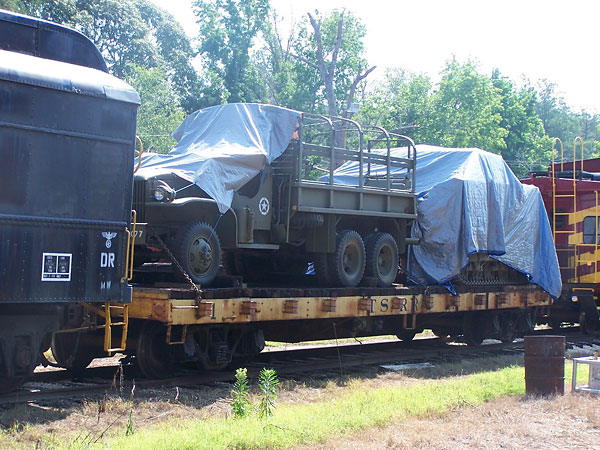
At the time of our visit, a collection of WWII military equipment was being prepared and loaded up
for a historical reenactment. A replica of General Patton's staff car had been specially prepared
for the purpose. Texas State Railway's collection have also appeared in quite a few motion pictures.
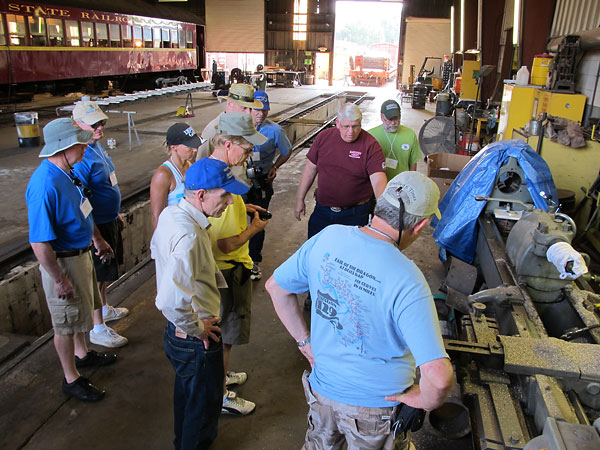
Yep, that's a really big lathe alright. So big, in fact, that it won't fit in the facility's main machine
shop. (The main machine shop was around the corner to the right.) The Texas State Railway staff
has to make a very high proportion of their own service and restoration parts from scratch.

A large passenger car is currently in the workshop for restoration.
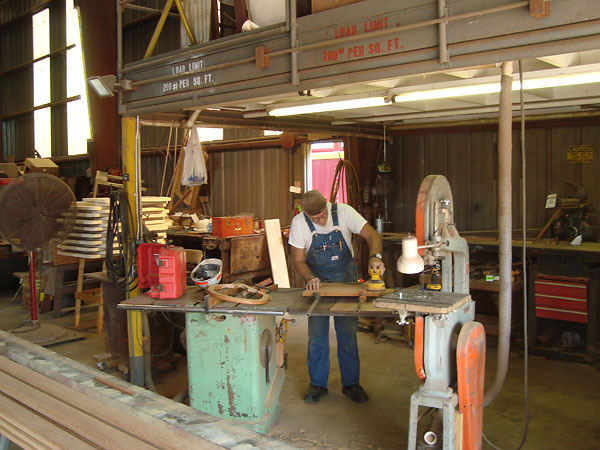
It took mountains of coal to power the steam trains, and it took mountains of wood to build them.
The Texas State Railway's steam locomotives have been converted to burn oil instead of coal,
but woodworking will remain a major part of the restoration shop's activity.

6500 gallons of water for engine 300. 5300 gallons of water for engine 201. Steam locomotives could
carry enough coal to travel long distances, but they typically had to stop every twenty miles or so
to refill the water supply for their boilers. The railroads employed people at all those watering
points, all across North America, not to mention huge legions of track maintenance people.
Disclaimer: This page was researched and written by Curtis Jacobson and Larry Shimp.
Views expressed are those of the authors, and are provided without warrantee or guarantee.
Apply at your own risk.
Photos by Curtis Jacobson, Artie Clark and Graham Creswick for BritishV8 Magazine. All rights reserved.

